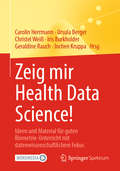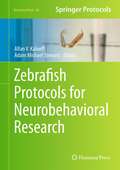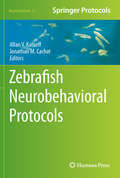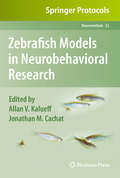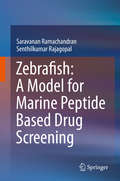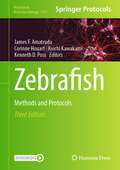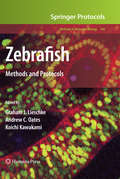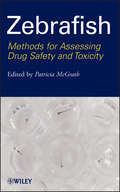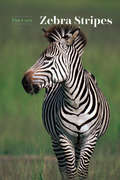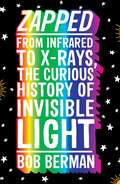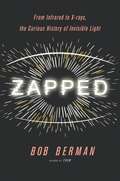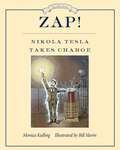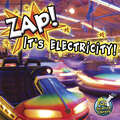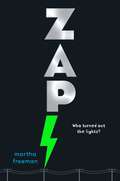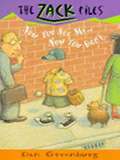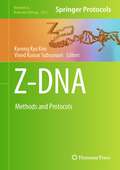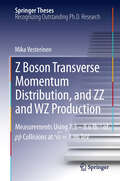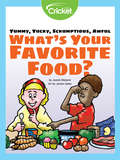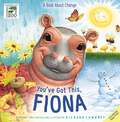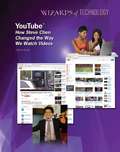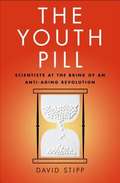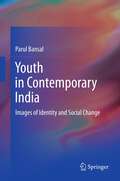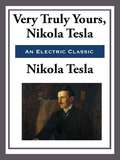- Table View
- List View
Zeig mir Health Data Science!: Ideen und Material für guten Biometrie-Unterricht mit datenwissenschaftlichem Fokus
by Carolin Herrmann Ursula Berger Christel Weiß Iris Burkholder Geraldine Rauch Jochen KruppaIn diesem Buch sind Lehrbeispiele gesammelt, die Dozierenden wertvolle Anregungen für ihre eigene Lehre liefern: Es werden Ideen für einzelne Übungen, Unterrichtseinheiten, Prüfungen oder ganze Kurse vorgestellt. Die benötigten Materialien sind für die Nutzer online frei verfügbar, um die Anwendung zu vereinfachen. Alle Beiträge dieses Buches wurden 2020 für den Preis für das beste Health-Data-Science-Lehrmaterial eingereicht, der von der Arbeitsgruppe Lehre und Didaktik der Biometrie der Deutschen Region der Internationalen Biometrischen Gesellschaft und der GMDS ausgeschrieben wurde. So entstand ein breiter Querschnitt an Beiträgen für lebendige Lehre in Biometrie, Epidemiologie, Public Health und ähnlichen Gebieten. Das Buch knüpft damit an die beiden Bände Zeig mir Biostatistik! und Zeig mir mehr Biostatistik! an, denen ähnliche Ausschreibungen vorausgingen. Die Herausgeber unterrichten Biometrie als Haupt- oder Nebenfach an verschiedenen Universitäten bzw. Hochschulen. Es verbindet sie das gemeinsame Ziel, den Austausch von Ideen und ausgereiftem Unterrichtsmaterial im Bereich Health Data Science zu fördern.
Zebrafish Protocols for Neurobehavioral Research
by Adam Michael Stewart Allan V. KalueffZebrafish (Danio rerio) play an integral role in biomedical research, enabling researchers to examine physiological mechanisms and pathways relevant to human pathogenesis and its therapy. That, along with their low cost, easy manipulation, short reproductive cycles, and physiological homology to humans, has made zebrafish a vital model organism for neuroscience research. Zebrafish Protocols for Neurobehavioral Research addresses protocols for both larval and adult models, written by the leading experts in the field of zebrafish research. Part I of this book takes advantage of the high-throughput nature of larval models to offer protocols for research requiring high output, easily manipulated screens. The second half of the book focuses on the robust and sophisticated behaviors of adult zebrafish, suitable for the neurophenotyping of complex traits and multi-domain disorders. Importantly, these models complement each other, working together to provide researchers with valuable insights into neurobiology of normal and pathological behavior. Thorough and cutting-edge, this volume is a useful, authoritative reference guide that should hold a coveted spot in zebrafish laboratories across the globe.
Zebrafish Neurobehavioral Protocols
by Jonathan M. Cachat Allan V. KalueffAs a model organism, zebrafish (Danio rerio) offer an opportunity to perform steadfast scientific investigations in a robust and high-throughput manner. In Zebrafish Neurobehavioral Protocols, experts in the field provide a series of detailed behavioral protocols dealing with the major current research areas in the field of behavioral neuroscience. The chapters discuss the use and interpretation of video-aided quantification of zebrafish behaviors, describe novel assays commonly used to quantify emotionality, learning, memory, and social behaviors in zebrafish, and instruct how to quantify endocrine responses and correlate them with behavior. Written in the Neuromethods series format, the chapters provide authoritative reviews of many commonly used approaches in the field today. This "how to" book will be a useful practical guide for zebrafish researchers and will complement another related book from this series, Zebrafish Models in Neurobehavioral Research. Cutting-edge and timely, Zebrafish Neurobehavioral Protocols serves as an excellent compilation epitomizing the growing potential of zebrafish in modern scientific inquiry.
Zebrafish Models in Neurobehavioral Research
by Allan V. Kalueff Jonathan M. CachatAnimal models have traditionally played a crucial role in improving our understanding of brain pathogenesis. Zebrafish (Danio rerio) have generated considerable discoveries in the areas of genetics, embryology, endocrinology, and neuroscience. Zebrafish Models in Neurobehavioral Research emphasizes the growing importance of zebrafish in neurobehavioral research and portrays an extensive, thorough perspective on the emergence of zebrafish as robust and translational models. Written by leading international experts, the book covers major topics ranging from stress to learned recognition of environment, encompassing a wide spectrum of the utility of zebrafish within neurobiological disciplines. The chapters provide authoritative reviews of many zebrafish paradigms commonly used in the field today. This book will be a useful guide for zebrafish researchers, and will complement another related book from the popular Neuromethods series, Zebrafish Neurobehavioral Protocols. Comprehensive and up-to-date, Zebrafish Models in Neurobehavioral Research serves as an ideal resource for scientists new to the field as well as for established researchers seeking valuable insight into the growing utility of zebrafish in neuroscience.
Zebrafish: A Model for Marine Peptide Based Drug Screening
by Saravanan Ramachandran Senthilkumar RajagopalThis book offers a comprehensive overview of toxicology, highlighting the significance of peptide-based toxins from marine environments. It discusses the principles of protein-carbohydrate and domain-domain interactions to increase our understanding of toxicology in zebrafish models, as well as drug interaction mechanisms and target definition in drug discovery. It also reviews the structure of marine peptides/toxins and the toxicology of peptide secreting cells and cells that respond to these enzymes, and describes the normal and abnormal toxicology of marine peptides in zebrafish models. Offering insights into the field of proteomics, particularly current practice and research models for solving its many riddles, the book also explains the analytical principles of marine protein-protein and protein-carbohydrate interaction in the context of teratogenicity in target identification in peptide- based drug discovery. Lastly, the book methodically examines the preclinical research on marine proteins/peptides.
Zebrafish: Methods and Protocols (Methods in Molecular Biology #2707)
by James F. Amatruda Corinne Houart Koichi Kawakami Kenneth D. PossThis fully updated edition introduces new tools, models, and analytic insights that position the zebrafish even more strongly as an engine of discovery for developmental and disease biology. Beginning with a section exploring detailed methods for use of zebrafish to model a variety of human diseases, the book continues by illuminating the key ongoing role of the fish model in studies of the vertebrate nervous system, tools and approaches using zebrafish to study stem cell and regenerative biology, as well as techniques in genetics and genomics. Written for the highly successful Methods in Molecular Biology series, chapters include introductions to their respective topics, lists of the necessary materials and reagents, step-by-step and readily reproducible laboratory protocols, as well as tips on troubleshooting and avoiding known pitfalls. Authoritative and up-to-date, Zebrafish: Methods and Protocols, Third Edition serves as an invaluable guide to propel advances in developmental biology, disease modeling, and regeneration research using zebrafish and medaka as model systems.
The Zebrafish: Atlas of Macroscopic and Microscopic Anatomy
by Joseph A. Holden Jennifer L. Matthews Lester J. LayfieldThe zebrafish (Danio rerio) is a valuable and common model for researchers working in the fields of genetics, oncology and developmental sciences. This full-color atlas will aid experimental design and interpretation in these areas by providing a fundamental understanding of zebrafish anatomy. Over 150 photomicrographs are included and can be used for direct comparison with histological slides, allowing quick and accurate identification of the anatomic structures of interest. Hematoxylin and eosin stained longitudinal and transverse sections demonstrate gross anatomic relationships and illustrate the microscopic anatomy of major organs. Unlike much of the current literature, this book is focused exclusively on the zebrafish, eliminating the need for researchers to exclude structures that are only found in other fish.
Zebrafish
by Koichi Kawakami Graham J. Lieschke Andrew C. OatesIn the last 20 years, research activity using the zebrafish Danio rerio has increased dramatically, due in part to the ease of breeding and raising them, their genetic tractability, embryonic accessibility, and their imaging potential. In Zebrafish: Methods and Protocols, expert researchers provide a collection of experimental techniques for the genetic modification, manipulation, and in vivo live imaging of zebrafish. This volume collects sophisticated and practical techniques, including several not yet widely known, from laboratories around the world. Written in the highly successful Methods in Molecular BiologyTM series format, chapters include brief introductions to their respective topics, lists of the necessary materials and reagents, step-by-step, readily reproducible laboratory protocols, and notes on troubleshooting and avoiding known pitfalls. Authoritative and accessible, Zebrafish: Methods and Protocols seeks to aid and inspire scientists utilizing this versatile animal model in their research.
Zebrafish
by Patricia McgrathZebrafish: Methods for Assessing Drug Safety and Toxicity offers a practical guide for using zebrafish as a tool for toxicology studies. Consolidating key protocols and approaches to help researchers navigate the important and evolving field of zebrafish models for toxicity screening, this new title describes the methods for using the zebrafish as a model organism to assess compound-induced toxicity on all major organs. Individual chapters that concentrate on assays for each organ system are included and various analytical tools including microscopy, microplate readers, high content imaging systems, ECG, blood pressure monitors, high speed video and motion detectors are described.
Zebra Stripes
by Tim CaroFrom eminent biologists like Alfred Russel Wallace and Charles Darwin to famous authors such as Rudyard Kipling in his Just So Stories, many people have asked, "Why do zebras have stripes?" There are many explanations, but until now hardly any have been seriously addressed or even tested. In Zebra Stripes, Tim Caro takes readers through a decade of painstaking fieldwork examining the significance of black-and-white striping and, after systematically dismissing every hypothesis for these markings with new data, he arrives at a surprising conclusion: zebra markings are nature's defense against biting fly annoyance. Popular explanations for stripes range from camouflage to confusion of predators, social facilitation, and even temperature regulation. It is a serious challenge to test these proposals on large animals living in the wild, but using a combination of careful observations, simple field experiments, comparative information, and logic, Caro is able to weigh up the pros and cons of each idea. Eventually--driven by experiments showing that biting flies avoid landing on striped surfaces, observations that striping is most intense where biting flies are abundant, and knowledge of zebras' susceptibility to biting flies and vulnerability to the diseases that flies carry--Caro concludes that black-and-white stripes are an adaptation to thwart biting fly attack. Not just a tale of one scientist's quest to solve a classic mystery of biology, Zebra Stripes is also a testament to the tremendous value of longitudinal research in behavioral ecology, demonstrating how observation, experiment, and comparative research can together reshape our understanding of the natural world.
Zapped: From Infrared to X-rays, the Curious History of Invisible Light
by Bob BermanThe universe is literally made of light One hundred years after they were written, Marie Curie&’s notebooks are still too radioactive to handle In 1974 we sent a message to star cluster M13. If any aliens respond promptly, we&’ll hear from them in 52000 From world-altering discoveries of the past to the wonderful science of the present, Bob Berman zooms across the universe to tell the story of invisible light. He reveals what microwaves from smartphones do to our brains, how birds use ultraviolet light to track prey, why gamma rays are the most powerful form of light, and so much more. Replete with amazing characters and mindboggling quantum leaps, Zapped offers a teasing peek into the future and some of the startling technologies we might yet live to see.
Zapped: From Infrared to X-rays, the Curious History of Invisible Light
by Bob BermanHow much do you know about the radiation all around you?Your electronic devices swarm with it; the sun bathes you in it. It's zooming at you from cell towers, microwave ovens, CT scans, mammogram machines, nuclear power plants, deep space, even the walls of your basement. You cannot see, hear, smell or feel it, but there is never a single second when it is not flying through your body. Too much of it will kill you, but without it you wouldn't live a year.From beloved popular science writer Bob Berman, ZAPPED tells the story of all the light we cannot see, tracing infrared, microwaves, ultraviolet, X-rays, gamma rays, radio waves and other forms of radiation from their historic, world-altering discoveries in the 19th century to their central role in our modern way of life, setting the record straight on health costs (and benefits) and exploring the consequences of our newest technologies. Lively, informative, and packed with fun facts and "eureka moments," ZAPPED will delight anyone interested in gaining a deeper understanding of our world.
Zap! Nikola Tesla Takes Charge (Great Idea Series #8)
by Monica KullingGrowing up in Smiljan, Croatia, Nikola Tesla dreamed about harnessing the power of Niagara Falls. In 1884, he walked down the gangplank into the New York Harbor with four cents in his pocket, a book of poems, a drawing of a flying machine, and a letter of introduction to Thomas Edison, the "electrical wizard" of America. Upon meeting, Edison sent Tesla to fix the SS Oregon as a test and was so astounded that he offered Tesla a job at his factory.Tesla and Edison had different views about electricity; Tesla wanted to develop an alternate current while Edison wanted to stick to the direct current system. Edison offered Tesla a large sum to make his direct current system more efficient, but when the work was done, Edison refused to pay. Tesla quit and when things were looking bleak, he met George Westinghouse, who also thought that alternating current was the way to light up America. He gave Tesla a job and in 1896, Tesla and Westinghouse built a generator at Niagara Falls that was able to send power as far as Buffalo, New York.
Zap! It's Electricity! (My Science Library)
by Buffy SilvermanIntermediate Readers Explore Electricity.
Zap!
by Martha FreemanEleven-year-old Luis is left looking for answers after a city-wide blackout leads him to an electrifying mystery in this edge-of-your-seat thriller from Martha Freeman.Luis Cardenal is toasting a Pop-Tart when a power outage strikes Hampton, New Jersey. Elevators and gas pumps fail right away; soon cell phones die and grocery shelves empty. Cold and in the dark, people begin to get desperate. Luis likes to know how things work, and the blackout gets him wondering: Where does the city’s electricity come from? What would cause it to shut down? No one seems to have answers, and rumors are flying. Then a slip of the tongue gives Luis and his ex best friend Maura a clue. Brushed off by the busy police, the two sixth graders determine they are on their own. To get to the bottom of the mystery, they know they need to brave the abandoned houses of Luis’s poor neighborhood and find the homeless teen legend known as Computer Genius. What they don’t know is that someone suspects they know too much, someone who wants to keep Hampton in the dark. In this electrifying mystery, two can-do sleuths embark on a high-tech urban adventure to answer an age-old question: Who turned out the lights?
Zack Files 12: Now You See Me....Now You Don't
by Dan GreenburgA hypnotist's show turns out to be way more than Zack bargains for when he is pulled out of the audience, put into a trance, and his body is "taken over" by the spirit of someone from the past. And that's only the beginning, because the stubborn spirit won't go away when the show's over! It's hard enough having just one self to worry about. What will Zack do with two?
Z-DNA: Methods and Protocols (Methods in Molecular Biology #2651)
by Kyeong Kyu Kim Vinod Kumar SubramaniThis detailed volume compiles key methods and techniques used to establish some of the structural and functional aspects of Z-form nucleic acids. Beginning with chapters on characterizing Z-DNA, the book continues by exploring structure determination techniques, gene- and genome-targeting methods and genome-wide approaches, Z-RNA study, and much more. Written for the highly successful Methods in Molecular Biology series, chapters include introductions to their respective topics, lists of the necessary materials and reagents, step-by-step and readily reproducible laboratory protocols, and tips on troubleshooting and avoiding known pitfalls. Authoritative and practical, Z-DNA: Methods and Protocols serves as an ideal guide for students and researchers curious about this unique Z nucleic acid as an area of investigation, aiming to help the field grow, flourish, and unravel the hidden and novel roles of Z. Chapter 1 is available open access under a Creative Commons Attribution 4.0 International License via link.springer.com.This is an open access book.
Z Boson Transverse Momentum Distribution, and ZZ and WZ Production
by Mika VesterinenThis work develops novel data analysis techniques enabling aspects of the Standard Model of particle physics to be tested with unprecedented precision using data from the DZero experiment at the high energy "Tevatron" proton-antiproton collider at Fermilab, Chicago. Vesterinen's measurements of the transverse momentum of Z bosons using the novel variable φ* have exposed deficiencies in the current state-of-the-art theoretical predictions for vector boson production at hadron colliders. These techniques are now being used in the experiments at CERN's Large Hadron Collider (LHC) and have stimulated considerable interest in the theoretical particle physics community. Furthermore, Vesterinen's measurements of the cross sections for the production of pairs of vector bosons (WZ and ZZ) are to date the most precise ever made.
Yummy, Yucky, Scrumptious, Awful: What's Your Favorite Food?
by Jeanie MebaneDid you know why foods taste different? Food flavors are not just about taste–your sense of smell helps you taste too! Your nose sends messages to your brain about the taste and smell of different foods. Sour and sweet tastes mix to form flavors like orange juice and lemonade. Discover the five tastes your tongue’s taste buds sense. Can you guess what scientists identified as the fifth taste?
The Yucky Reptile Alphabet Book (Jerry Pallotta's Alphabet Books)
by Jerry PallottaFind out why boa constrictors swallow their meals whole, learn why gila monster's tails are so fat, and meet a lizard that is larger than most people.As young readers turn the pages of this beautifully illustrated book, they will find that reptiles aren't really so "yucky." In fact, reptiles are among nature's most exotic and intriguing animals.Jerry Pallotta's well-researched text and Ralph Masiello's vivid illustrations will enthrall young and not-so-young readers alike.
You've Got This, Fiona: A Book About Change (A Fiona the Hippo Book)
by ZondervanJoin your favorite hippo, Fiona, the adorable internet sensation from the Cincinnati Zoo and Botanical Garden, in this perfect read-aloud picture book, You&’ve Got This, Fiona, as she learns about the changing seasons of the year and how, even when things change around you, true friendship, family, and love stay the same.Fiona notices that things are changing—her friends the geese are flying south, the leaves are turning different colors and the weather is getting cooler, her baby brother Fritz is born and brings change to Hippo Cove. But Fiona also wonders is everyone and everything going to change? Fiona gets a little worried … and so she heads to Mama and her friends, looking for answers. You've Got This, Fiona:is the perfect story to read aloud to children ages 4 to 8.features art by New York Times bestselling artist Richard Cowdrey (Fiona the Hippo,Bad Dog, Marley)takes kids through the seasons of the year at the zoohelps children see that change—from the seasons to new babies in the family--is normal and it&’s ok to be unsure about changeintroduces Fiona&’s baby brother Fritz, who was born at the Cincinnati Zoo and Botanical Gardens in August 2022 You've Got This, Fiona is the perfect gift for Fiona enthusiasts and any gift-giving opportunity.A follow-up to the New York Times bestselling Fiona the Hippo; A Very Fiona Christmas; Fiona, It&’s Bedtime, and Fiona Helps a Friend, You&’ve Got This, Fiona showcases the fearless hippo that&’s as much of a star at the zoo (in the real world) as she is online!
YouTube®: How Steve Chen Changed the Way We Watch Videos
by Celicia ScottYou probably watch music videos, movie trailers, or funny clips on YouTube--but just a few years ago, YouTube was only an idea a few friends shared. One of those friends was Steve Chen. Learn about the beginning of one of the most important websites ever created. Discover the story of how Steve helped to start the biggest video site on the Internet.
The Youth Pill
by David StippLiving longer is closer than we think. Even before the first person set off to find the Fountain of Youth, we were searching for a way to live longer. But promises of life extension have long reeked of snake oil, and despite our wishful thinking—not to mention the number of vitamins we pop—few of us believe we’ll live to see one hundred, much less set a longevity record. But now scientists are closing in on true breakthroughs in anti-aging. Compounds that dramatically extend the health spans of animals, including mammals, have recently been demonstrated in the lab, and gerontologists now generally agree that drugs that slow human aging and greatly boost health in later life are no longer a distant dream. David Stipp, a veteran science journalist, tells the story of these momentous developments and the scientists behind them, providing a definitive, engaging account of some of the most exciting (and sometimes controversial) advances that promise to change the way we live forever. .
Youth in Contemporary India
by Parul BansalThis book endeavors to be a study of identity in Indian urban youth. It is concerned with understanding the psychological themes of conformity, rebellion, individuation, relatedness, initiative and ideological values which pervade youths' search for identity within the Indian cultural milieu, specifically the Indian family. In its essence, the book attempts to explore how in contemporary India the emerging sense of individuality in youth is seeking its own balance of relationality with parental figures and cohesion with social order. The research questions are addressed to two groups of young men and women in the age group of 20-29 years-Youth in Corporate sector and Youth in Non Profit sector. Methodologically, the study is a psychoanalytically informed, process oriented, context sensitive work that proceeds via narrations, conversations and in-depth life stories of young men and women. Overall, the text reflects on the nature of inter-generational continuity and shifts in India.
Yours Truly, Nikola Tesla
by Nikola TeslaNikola Tesla was a man of letters. He wrote many letters to the editors of the magazines and newspapers of his day. These letters give a fascinating glimpse into the mind of an eccentric genius. Collected here for the first time are more than forty of Nikola Tesla's letters. The subject matter ranges widely, as Tesla was interested in almost everything. In these letters he responds to Marconi and Edison, gives his thoughts on the wars of his day, corrects inconsistencies in news reports, and much much more. Nikola Tesla has been called the most important man of the 20th Century. Without Tesla's ground-breaking work we' d all be sitting in the dark without even a radio to listen to.
